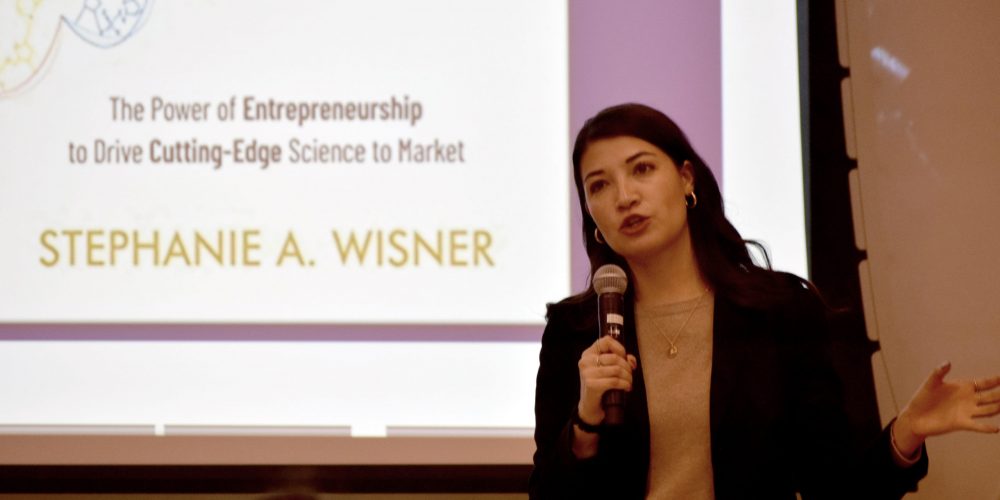Entrepreneurship allows biotechnology researchers to help people by bringing their innovations out of the lab and into the market. However, this process tends to be expensive and lengthy — not to mention the high failure rate of biotech startups. What does it take for a biotech company to succeed in such a challenging market?
Stephanie Wisner ’16, cofounder of biotech startup Centivax, answers that question in her new book, “Building Backwards to Biotech: The Power of Entrepreneurship to Drive Cutting Edge Science to Market.” She discussed her findings, as well as her career path and expertise on the biotech industry, with the entrepreneurial community at Cornell on Nov. 18.
Originally planning to attend medical school, Wisner noticed a twofold problem in the medical field: Innovations rarely make it out of the lab, yet patients desperately need new innovations to go to market.
Identifying this problem led Wisner to complete a National Science Foundation (NSF) I-Corps Regional Course hosted by Cornell in 2017. The course showed her how entrepreneurship in science could bridge the innovation gap she had witnessed.
“I always kind of thought the point of business is money, and I’m not really interested in money so I’m going to do science,” Wisner said. “I was surprised to find out when I did I-Corps that the function of business is, of course, to make money, but a business can’t make money if it’s not actually solving a problem for real people.”
Just a few months after the I-Corps course, Wisner started business school at the University of Chicago. She co-founded Centivax in 2020 as Chief Business Officer, and she also runs a consulting business, BioVenture Advising LLC, advising biotech startups on business and commercialization strategy. In 2022, she was named to the Forbes 30 Under 30 list for Healthcare.
In an industry fraught with failure, Wisner has thrived. She decided to write a book to determine what differentiates successful biotech startups and educate scientists about business. Over the course of hundreds of interviews with industry leaders, Wisner noticed a way of thinking that she calls “building backwards.”
“Building backwards is building with the end in mind so that you can optimize your path to pursue an end goal,” Wisner said. “This is a mindset, not a protocol or a series of steps to follow, which is adaptable to any unforeseen scientific complications.”
Wisner’s company demonstrates the benefits of building backwards — Centivax recently raised $10 million in a Series A funding round led by NFX and the Global Health Investment Corporation for its universal vaccine technology. The team built the company around a goal to make vaccines, starting with influenza and COVID-19, more effective against viral mutations.
To conclude her presentation, Wisner explained how other biotech entrepreneurs can apply building backwards to their own companies:
1. Make sure the market for your innovation is large enough to attract investors. “To get all the way through the drug development timeline, you almost certainly are going to have to raise with an investor at some point,” Wisner said. “Investors care about getting returns, so if your end market size is not big enough to reward you, and them, and their investors, they’re never going to invest.”
2. Differentiate your technology. While large companies can afford to make incremental changes, startups need to make revolutionary changes to get off the ground. New technologies need to be 10x better on multiple metrics, such as cost, specificity, or world-changing potential.
3. Keep in mind that doing experiments in business is very different than in academia. “You have to be really strategic and think about what the minimum data package you need is to raise the next round, to go into the clinic, to do the next step, whatever that big value inflection point is for your company,” Wisner said.
4. Fill your team with experienced people. The Centivax team is filled with biotech entrepreneurs who have brought cutting-edge innovations to market before and know how to do it again.
5. Ensure that you have a good intellectual property (IP) position from day one. “If you so much as talk about your cutting-edge new technology before you file a provisional patent, you can no longer patent it, which means that you can never start a company around it,” Wisner said. “You need to think very carefully about what you’re talking about, presenting, or publishing on and the timing of that.”
After the presentation, audience members had the opportunity to ask Wisner questions and receive free signed copies of the book.
W.E. Cornell, the Center for Regional Economic Advancement (CREA), Cornell Institute for Food Systems (CIFS), Cornell Division of Nutritional Sciences, Center for Life Science Ventures, Entrepreneurship at Cornell, and Careers Beyond Academia all collaborated to make this event possible.






